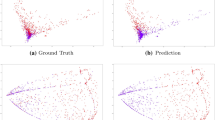Abstract
In this study, we apply a non-negative matrix factorization approach for the extraction and detection of concepts or topics from electronic mail messages. For the publicly released Enron electronic mail collection, we encode sparse term-by-message matrices and use a low rank non-negative matrix factorization algorithm to preserve natural data non-negativity and avoid subtractive basis vector and encoding interactions present in techniques such as principal component analysis. Results in topic detection and message clustering are discussed in the context of published Enron business practices and activities, and benchmarks addressing the computational complexity of our approach are provided. The resulting basis vectors and matrix projections of this approach can be used to identify and monitor underlying semantic features (topics) and message clusters in a general or high-level way without the need to read individual electronic mail messages.
Similar content being viewed by others
Explore related subjects
Discover the latest articles, news and stories from top researchers in related subjects.References
Berry, M. and M. Browne (2005), Understanding Search Engines: Mathematical Modeling and Text Retrieval (2nd ed.). Philadelphia, PA: SIAM.
Berry, M., Z. Drmač, and E. Jessup (1999), “Matrices, Vector Spaces, and Information Retrieval,” SIAM Review, 41(2), 335–362.
Donoho, D. and V. Stodden (2003), “When does Non-Negative Matrix Factorization Give a Correct Decomposition into Parts?” Technical report,Department of Statistics, Stanford University. Preprint.
Giles, J., L. Wo, and M. Berry (2003), “GTP (General Text Parser) Softwarefor Text Mining,” in H. Bozdogan (Ed.), Software for Text Mining, in Statistical Data Mining and Knowledge Discovery, Boca Raton,FL: CRC Press, pp. 455–471.
Grieve, T. (2003, October 14). The Decline and Fall of the Enron Empire.Slate. http://www.salon.com/news/feature/2003/10/14/enron/index_np.html.
Guillamet, D. and J. Vitria (2002), “Determining a Suitable Metricwhen Using Non-Negative Matrix Factorization,” in Sixteenth International Conference on Pattern Recognition (ICPR'02), Vol. 2, Quebec City, QC, Canada.
Hoyer, P. (2002), “Non-Negative Sparse Coding,” in Proceedings of the IEEEWorkshop on Neural Networks for Signal Processing, Martigny, Switzerland.
Hyvärinen, A. and P. Hoyer (2000), “Emergence of Phase and Shift Invariant Features by Decomposition of Natural Images into Independent Feature Subspaces,” Neural Computation, 12(7), 1705–1720.
Jolliffe, I. (2002), Principle Component Analysis (2nd ed.).New York: Springer-Verlag.
Keila, P. and D. Skillicorn (2005, April 23), “Structure in the Enron Email Dataset,” in Proceedings of the Link Analysis, Counterterrorism, and Security Workshop, Fifth SIAM International Conference on Data Mining, Newport Beach, CA, pp. 55–64.
Lee, D. and H. Seung (1999), “Learning the Parts of Objects by Non-Negative Matrix Factorization,” Nature, 401, 788–791.
Lee, D. and H. Seung (2001), “Algorithms for Non-Negative Matrix Factorization,” Advances in Neural Information Processing Systems, 13, 556–562.
Liu, W. and J. Yi (2003), “Existing and New Algorithms for Non-Negative Matrix Factorization,” Technical report, Departmentof Computer Sciences, University of Texas at Austin. Preprint.
McCallum, A., A. Corrada-Emmanuel, and X. Wang (2005, April 23). “The Author-Recipient-Topic Model for Topic and Role Discovery in Social Networks with Application to Enron and Academic Email,” in Proceedings ofthe Link Analysis, Counterterrorism, and Security Workshop, Fifth SIAMInternational Conference on Data Mining, Newport Beach, CA, pp. 33–44.
McLean, B. and P. Elkind (2003), The Smartest Guys in the Room: The Amazing Rise and Scandalous Fall of Enron. Portfolio.
Mu, Z., R. Plemmons, and P. Santago (2003), “Iterative Ultrasonic Signaland Image Deconvolution for Estimating the Complex Medium Response,”in IEEE Transactions on Ultrasonics and Frequency Control, IEEE, Submitted for publication.
Prasad, S., T. Torgersen, V. Pauca, R. Plemmons, and J. van der Gracht(2003), “Restoring Images with Space Variant Blur via Pupil Phase Engineering,” Optics in Info. Systems, Special Issue on Comp. Imaging, SPIEInt. Tech. Group Newsletter, 14(2), 4–5.
Shahnaz, F., M. Berry, V. Pauca, and R. Plemmons (2006), “Document Clustering Using Nonnegative Matrix Factorization,” Information Processing and Management, 42(2), 373–386.
Xu, W., X. Liu, and Y. Gong (2003), “Document-Clustering based on Non-negative Matrix Factorization,” in Proceedings of SIGIR'03, July 28–August 1, Toronto, CA, pp. 267–273.
Author information
Authors and Affiliations
Corresponding author
Additional information
Michael W. Berry is a Professor and Interim Department Head in the Department of Computer Science at the University of Tennessee and a faculty member in the Graduate School in Genome Science and Technology Program at the University of Tennessee and Oak Ridge National Laboratory. His research interests include information retrieval, data mining, scientific computing, computational science, and numerical linear algebra. He is a member of the Society for Industrial and Applied Mathematics (SIAM), Association for Computing Machinery (ACM), and the Computer Society of the Institute of Electrical and Electronics (IEEE). Professor Berry is on the editorial boards of “Computing in Science and Engineering” (IEEE Computer Society and the American Institute of Physics) and the SIAM Journal of Scientific Computing.
Murray Browne is a Research Associate in the Department of Computer Science at the University of Tennessee. He is a member of the American Society for Information Science and Technology and has published numerous essays, book reviews, newspaper articles, and feature stories.
Rights and permissions
About this article
Cite this article
Berry, M.W., Browne, M. Email Surveillance Using Non-negative Matrix Factorization. Comput Math Organiz Theor 11, 249–264 (2005). https://doi.org/10.1007/s10588-005-5380-5
Published:
Issue Date:
DOI: https://doi.org/10.1007/s10588-005-5380-5




